Hello, fellow lovers of all things green. There’s an Old Farmer’s Almanac calendar above my desk, noting Friday, April 13th, is Thomas Jefferson’s Birthday – he lived from 1743 to 1826. Beyond being a founding father and the third president of the United States, Jefferson was a philosopher, a scientist, and a proponent of plants. Jefferson’s birthdate recalls my visit to Monticello; some consider a “lab for plants” in Charlottesville, VA. I cherish the memory of my last garden tour there with my dear mom before her final stages of dementia.
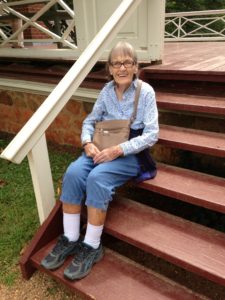
Mom in Monticello
Thomas Jefferson initiated the Lewis and Clark Expedition to explore and map the territory acquired leading to the West Coast after the Louisiana Purchase to establish an American presence there. From May 1804 to September 1806, the expedition’s objectives were also economically and scientifically driven—to discover and research the region’s plants, animals, and geography and establish trade relationships with Native American tribes.
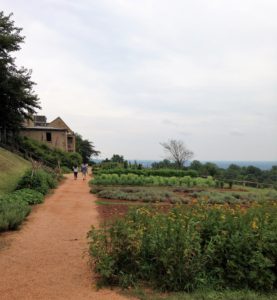
The vegetable gardens served as a horticultural laboratory.
About Jefferson’s Monticello Plantation
The essence of the plantation’s history is moving—learning about Jefferson’s initiatives to experiment with ornamental and edible plants found natively and around the world and hearing about his pursuit to develop agricultural practices that he felt would be the backbone of our economy and independence. With that, the horrific and heartbreaking history of those enslaved who worked the land.
It’s fascinating to learn about Jefferson’s trials and tribulations. He deliberately planted castor beans to deter moles without success, though an oil distilled from the beans and applied to the soil may work. However, as with medicinal castor oil, the poisonous ricin is removed during distillation. Thomas Jefferson cultivated a castor bean plant that grew 22 feet tall, fitting for his competitive nature. I adore using castor bean plants, an annual here, in the garden as a lovely seasonal screen or specimen,
The Garden Book
Jefferson kept a log known as the Garden Book, documenting vegetation, diseases, and insects in the vast gardens he meticulously designed and monitored. His flower gardens comprised twenty oval-shaped beds around the house, each planted with a different flower. Plus, a winding flower border every ten feet – a distinct species encompassed the West Lawn, the view on our nickel.
The array of species reflected Thomas Jefferson’s floral interest, a museum of sorts; about twenty-five percent were North American native plants. The winding border of the curving walk also reflected his interest in informal landscape design, transgressing from the formal designs of the earlier era. Then, the extensive vegetable gardens served as a horticultural laboratory and food source.
Jefferson humbly wrote his epitaph.
Towards the end of his life, Jefferson designed his gravestone and wrote the engraved epitaph. “Here was buried Thomas Jefferson. Author of the Declaration of American Independence… Of the Statute of Virginia for religious freedom & Father of the University of Virginia.” It’s fascinating he made no mention of his presidency. Instead, he mentioned his contribution to independence, freedom, and learning.
Standing before Thomas Jefferson’s grave with his own words about his life stirred immense pride in his remarkable contributions. Despite controversies and injustices, I sensed self-awareness and perhaps shame for offenses and imperfections. But I believe goodness and even beauty can shine above failings, as we can do in our garden of life.
May we learn from history rather than erase or ignore it so that we continue to become better than we used to be.
Garden Dilemmas? AskMaryStone@gmail.com and your favorite Podcast App.
Link to a related story: Castor Bean Plants Hide’ Uglies’
There’s more to the story in the Garden Dilemmas Podcast (a soothing 10 minutes):
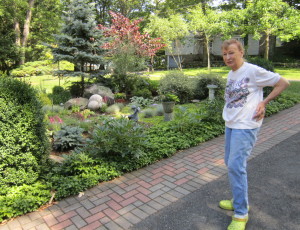
Barbara Vey
“Enough is Enough”
I introduced castor bean plants to a beloved client, who became a friend thinking we found a sure win on deer resistance because of toxicity. It turns out the darn deer chopped the plants and spit them out. I joke that Barbara moved to the Carolinas to escape her deer dilemma. She hoped to find the culprit writhing in abdominal pain or worse, preferably dead. I should mention that Barbara is a kind, loving soul. But “Enough is Enough!” As she said those words, I cracked up.
You know, we can say that about a lot of things, can’t we? Enough is Enough. May we all learn to be kind to each other. Accept our differences, our uniquenesses, because, in many ways, we are the same. Wanting to enjoy our lives, take care of our families, and live comfortably and peacefully. That is my wish for all.
Thomas Jefferson’s Monticello is often one of 250 historical landmarks, beautiful homes, and gardens in Virginia’s annual Historic Garden Week. (visit vagardenweek.org for information)


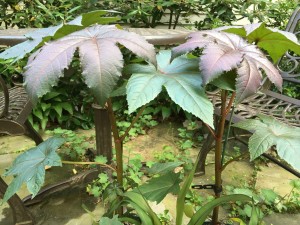
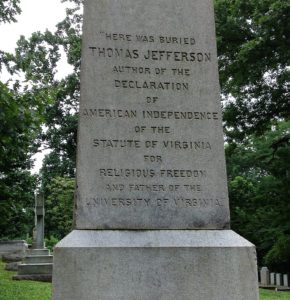

Thanks Mary for a lovely article about Thomas Jefferson. Truly an amazing person…..
Indeed he was. Thank you, April!
I love the quote attributed to Jefferson, “I may be an old man, but I am a young gardener.”
Always learning, never fully arriving. I was thinking the other day how Mary at the garden mistook Jesus for the gardener. Why was that? Was he tending plants? Smelling flowers? I wonder if he wasn’t “taking a minute in the garden”. He had just undergone the Trauma of the Ages and needed to recover a bit before proceeding with the plan and engaging once again with His people. And of course the Lord set us in The garden of Eden. And liked to visit us there.
Hi Linea, I love the Jefferson quote you shared! Indeed, gardeners are constantly learning and, therefore, remain forever young. Thank you for sharing the Garden of Eden story, too. See that? Always learning. Happy gardening, Mary
Great piece! Love how you connect politics, plants and mom! I found the epitaph very humble and maybe it mentions the most profound things, freedom, independence, choice and education! One of your best posts. Have you changed the font on your site by the way? I’m not so fond of it…
Thank you for your kind words. Writing the story brings back the memory of walking the grounds of history with my dear mom, who gave me my garden start. I haven’t changed the font (that I know of) unless the WordPress Theme changed it for me (smile). I appreciate your feedback! Mary